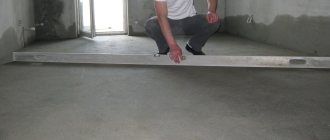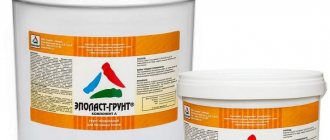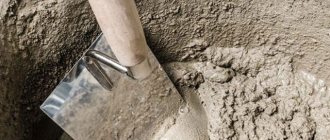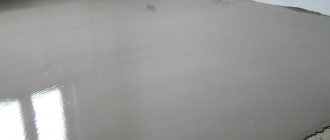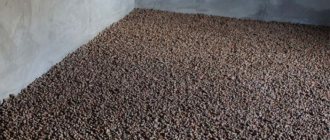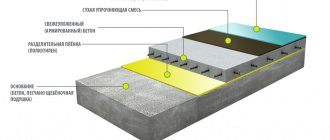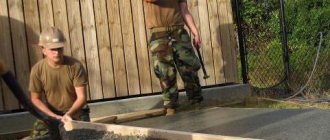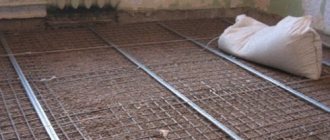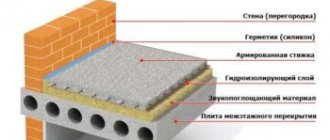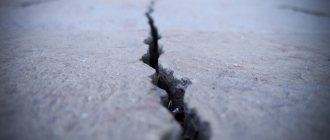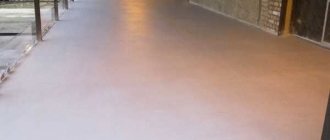What is sand concrete?
Depending on the sand fraction, sand cement can belong to fine- and coarse-grained mixtures. If you need to arrange a rough foundation with your own hands, the question often arises: what material to use for pouring the screed?
Traditional cement-sand mortars are inexpensive, but if a significant mechanical load is created on the coating, they begin to crack. Liquid sand concrete mixture does not have such disadvantages. What is she? Sand concrete is a special composition that includes the following components:
- Portland cement;
- synthetic substances (plasticizers, pigments);
- sand.
The above substances affect not only the consistency of the solution, but also the wear resistance of the screed itself. Depending on the fraction of sand that is included in the mixture, sand cement can be classified as fine- and coarse-grained concrete.
Under tiles
Most often, a cement mixture is used to level the floor under the tiles. You can walk on this floor within the next 24 hours, but here’s what to do with the finishing. Based on the experience of already experienced people, we can say that the process of installing tiles can be carried out the next day. This is completely harmless, although not entirely advisable. If you entrusted the process of performing the work to strangers, then it is very important to check whether reinforcement was done.
The thickness of the screed to be poured must be at least 4.5 cm. If the required thickness cannot be achieved, then the following measures must be taken: lay a plastic mesh with small cells on the screed. It is sold in rolls at any hardware store. After this, be sure to secure it with nails and cover it with a dry adhesive mixture, which will be used when laying the tiles.
The video shows how long it takes for a floor screed to dry:
A screed is a very necessary element to achieve a perfectly flat floor surface. Today there is a wide range of materials from which it can be made. As a result, it is very difficult to accurately determine the drying time of the solution used. In addition, it is worth taking into account factors such as temperature, layer thickness, humidity level and the type of material used. You may also be interested in the disadvantages of dry screed. The link describes it. The advantages of semi-dry floor screed are described. Also read,. To strengthen, they often produce a.
Sand concrete M300 - this mixture, made on the basis of Portland cement, purified river sand and plasticizer additives, provides an excellent base for any floor coverings, good waterproofing and adhesion to the floor slab.
One of the questions that arises among builders after pouring floors is how long it takes M300 sand concrete to dry. In other words, how long after pouring should you not enter the room in which the fresh screed was made?
Analysis of sand concrete composition
When finishing a subfloor with your own hands, you need to take into account many characteristics of the coating:
- presence of temperature changes in the room;
- intensity of floor use;
- indoor humidity level;
- type of foundation or floor (presence of a basement).
When arranging foundations in rooms with a specific microclimate, you should not use a regular cement screed. Why? The resulting coating has high hygroscopicity and capillarity, so moisture easily penetrates deep into the base and destroys the reinforcing mesh. Over time, this affects the integrity of the subfloor and finishing floor.
Sand concrete contains granite screenings.
What material is best to choose in this case? As practice shows, sand concrete has good moisture resistance and frost resistance. One cannot discount the insignificant consumption of the material itself, which is due to the high plasticity and fluidity of the solution. However, the technical characteristics of the sand-cement composition are influenced by the concentration and presence of individual components.
But no matter what mixture you choose for the subfloor, it will definitely include the following substances:
Cost of concrete floor screed per m2
- granite screening;
- fine or coarse sand;
- Portland cement.
However, the technical characteristics of the screed are influenced by the additives included in the mixture, which include:
- plasticizers;
- antibacterial substances;
- retarders and accelerators of the screed curing process.
What sand concrete is best to choose in this case? The type of composition chosen directly depends on the conditions of use. When pouring a solution onto a small base area, it is more advisable to give preference to solutions with a quick hardening period. If you need to equip a larger subfloor, it is better to opt for compounds with a long curing time.
HIGH STRENGTH FLOOR SCREED, 40 kg
FLOOR SCREED
– a highly effective material based on cement binder, coarse sand (grain size up to 5 mm) and modifying additives.
The material has high strength and adhesion to the base, is flexible, easy to level and smooth. After setting, a strong and smooth surface is formed.
According to its performance characteristics, it is waterproof and frost-resistant.
APPLICATION AREA
The mixture is intended for leveling horizontal surfaces with significant differences (up to 150mm) and creating a strong and level floor base, as well as for giving the floor the required slope in residential, public and industrial premises for various purposes.
Used for use in “Warm Floor” systems.
For interior and exterior use.
It is used on concrete, cement-sand bases.
Surface preparation:
The base must be solid, clean, free from dust, dirt and peeling. Substances that weaken adhesion: oil, dust, paint must be removed. Pre-fill any potholes, seams or cracks on the surface. To increase the adhesion strength to the base, it is necessary to treat the surface using a deep penetration primer "Rusean". After applying the primer, let it dry.
A damper tape should be laid around the perimeter of the screed pouring area.
The screed must contain temperature-shrinkage and expansion joints. The distance between seams in a monolithic screed should not exceed 6 meters. The seams must be embroidered with a polymer elastic composition.
Preparation of the solution:
Gradually pour a bag of dry mixture (40 kg) into a container with 4 - 4.8 liters of clean water, stirring at the same time. Mix using a professional mixer (with a power of at least 800W) with an attachment for 1-3 minutes until a homogeneous consistency is obtained.
Execution of work:
Beacons are installed on the prepared base every 1.5-2 meters. The correct installation of the beacons is checked with a level or level. The prepared solution is laid out on the base within 70-90 minutes after mixing with water, and then smoothed with a rule. Final leveling and smoothing is done using a metal spatula or grater. When installing screeds in rooms with increased load on the floor (garages, walkways, foyers, corridors, etc.), it is recommended to use reinforcing mesh.
During work and for 1 day after completion, the surface must be protected from intense drying by covering it with plastic film. Avoid exposure to direct sunlight and drafts.
Minimum strength sufficient for walking on the surface is achieved after 48 hours.
The time for laying subsequent materials is after the screed has dried. Drying time depends on temperature, humidity level and layer thickness.
It is not recommended to use the finished screed without a floor covering (tiles, linoleum, etc.).
ATTENTION!
Do not use dirty tools or containers for work. No other components may be added. When working with the mixture, avoid drafts and direct sunlight. The presence of thin thread-like shrinkage cracks is not a defect.
CONSUMPTION
Average consumption is 21-22 kg per 1 m2 with a layer thickness of 10 mm.
STORAGE
Store bags in a dry place on wooden pallets; use material from damaged bags first. Shelf life in undamaged packaging is 6 months.
Bag weight 40kg +- 1%
Advantages and disadvantages of sand concrete materials
The quality of sand-concrete compositions is affected not only by the amount of additional ingredients, but also by the brand of cement used.
When repairing a floor with your own hands, not everyone understands what criteria should be used to choose mixtures for applying screed. But experienced craftsmen choose sand concrete due to the following advantages:
- Easy to prepare solution;
- Long service life of the screed;
- Resistance to corrosive processes;
- Resistance to temperature changes;
- Good sound and heat insulating qualities;
- High frost resistance.
Important! The quality of sand concrete compositions is affected not only by the amount of additional ingredients, but also by the brand of cement used. When choosing a material with your own hands, it is worth knowing that there are several disadvantages of special screeds, namely:
- The price of sand concrete mixtures is higher than conventional cement ones;
- If the sequence of mixing the components of the mixture is not followed, the technical characteristics of the subfloor may significantly deteriorate;
- When diluting a solution with your own hands, without special equipment, it is difficult to track the degree of its homogeneity.
Types of sand concrete
The price of M500 grade cement is quite high and therefore it is used extremely rarely in the process of laying screeds
. As already noted, sand concrete can be of several types and its technical parameters are largely influenced by the grade of cement. The following grades of cement can be used to produce the material:
- M150 - used for masonry work: eliminating defects on the base, leveling the floor or laying facing materials;
- M200 – suitable for arranging screeds indoors;
- M300 - used for preparing concrete castings, arranging a rough screed or foundation;
- M500 is the best of all the above types of sand cement, which is suitable for most masonry work.
It should be noted that the price of M500 cement is quite high and therefore it is used extremely rarely in the process of laying screeds. But M300, in its physical and mechanical characteristics, is not much inferior to high-quality material, but it costs much less.
Here are the brands (they all start with the letter M) that are most frequently used:
- 150 - usually used when eliminating any defects in the base or when laying facing materials.
- 200 – needed for screeds that are made indoors.
- 300 - used mainly for foundations, but can easily replace M500.
- 500 is the best and most versatile option that can be used for almost all masonry work.
Well, we have come to the end of the conversation about genders. More precisely, about one of the options for making a screed. And this, believe me, not only broadens your horizons, it gives you confidence in your practical actions. For example, you wanted to improve your life in your apartment, and now you know not only where to start, but also what materials to use. Good luck!
If the article was useful to you, share it with your friends by clicking on the buttons: Below, leave your comments, suggestions, ask questions, express your opinion - this is very important to us!
Features of sand concrete M300
A sand-cement screed made from a mixture that includes M300 cement is most often used by builders when arranging a rough foundation. The increased interest in mortar is due to good technical parameters:
- High density of the prepared solution;
- The ability to use the mixture for internal and external work;
- Resistant to precipitation and low temperatures;
- The ability of the composition to self-level;
- Rapid hardening of the screed at positive temperatures.
It should also be noted that the price of M300 sand-cement mortars is low, so even significant consumption of material does not contribute to large financial expenses.
Calculation of the amount of mixture
An example of laying a semi-dry sand concrete screed.
Calculation of the required amount of sand concrete is carried out according to the following scheme:
Prices for dry mixes for floor screed
- First, the base area is calculated;
- Then the degree of height difference per m2 of base is calculated;
- After this, the consumption of the sand-cement composition is calculated using a certain formula.
How to calculate the amount of sand-cement mixture required? To accurately determine the consumption of mortar for arranging a rough foundation, consider an illustrative example:
- Let's say that we need to fill 30 m2 of base with sand cement with our own hands;
- The material consumption is mainly affected by the thickness of the screed, let’s say it is 4 cm;
- When calculating the required number of sand concrete bags, look on the packaging for the specific consumption of the prepared solution per m2 of coating with a layer thickness of 1 cm. Let’s assume that it is approximately 20 kg;
- To calculate the amount of composition, we make the following calculation: multiply the layer thickness by the specific consumption: 4 * 20 = 80 kg;
- Now, to find out the amount of material to fill the entire floor (30 m2), you need to multiply the resulting value by the total area of the base: 80 * 30 = 2400 kg.
So, the consumption of sand-cement mortar for arranging a floor with an area of 30 m2 will be 2400 kg. Now you need to determine the number of required bags of mixture:
- As a rule, the building composition is packaged in bags of 20, 30 or 50 kg. Let's say we need to buy the mixture in 30-kilogram bags;
- How many bags will you need? The calculation is made in accordance with the formula: divide the total weight of the required amount of composition by the weight of one bag;
- Using a calculator, we make a simple calculation: 2400/30 = 80 bags.
Construction material consumption
When a sand concrete floor screed is poured, the consumption is extremely dependent on the height of the layer. It is preferable to make calculations not relative to a square meter, but based on volumetric indicators. So, for example, the consumption when creating a coating of 20 m2 with a height of 10 cm (0.1 m) can be found out as follows:
- We calculate the volume of the structure: 0.1×20 = 2 m3.
- From 1.5 to 1.7 tons of powder are consumed per cubic meter. If you use 50 kg sand concrete, you will need 1500/50 = 30 packages. Considering that we will have to work with a large volume, we multiply the calculated bags by 2. 60 pieces or 3 tons of powder are required.
The basic formula is enough to find out how much sand concrete 40 kg (in any other container) will be needed when creating a support layer for the room.
Pouring process in an apartment or house
The technology does not require the mandatory use of specialist services. It consists of basic steps.
Preparation for work
Self-leveling floors are created only if there is a flat and clean surface. RC slabs must be inspected for defects or other flaws. The joints and corners that form walls and floors deserve special attention.
The pouring procedure is quite wet, because water will constantly be released from the composition. Its seepage through holes and cracks is unacceptable. All such elements are filled with building materials and also treated with bitumen or polymer substances for waterproofing.
Online calculator for calculations
Table for calculating the amount of cement of different brands
Since the sand concrete mixture may contain various plasticizers and additives, they can significantly affect the consumption of the prepared composition. To avoid laborious calculations, you can use an online calculator to quickly determine the required amount of material. Thanks to a clever program, not only the consumption, but also the price of the required amount of sand cement can be determined without any problems.
You need to enter the digital values of the following parameters into the calculator:
- base area;
- volume of solution;
- composition strength grade;
- type of sand (river, expanded clay, construction);
- brand of cement;
- type of plasticizer.
All of the above parameters, except the first, are indicated by the sand cement manufacturer on the packaging. After entering the data, the program determines the material consumption in kg in a matter of seconds. The average price is determined in accordance with the presence of plasticizers and the grade of cement.
